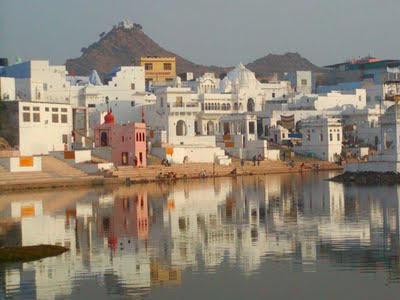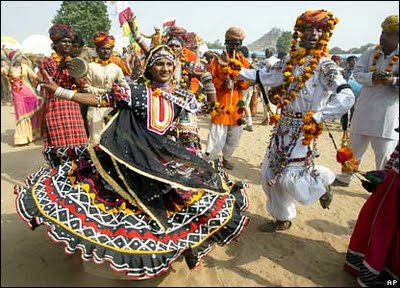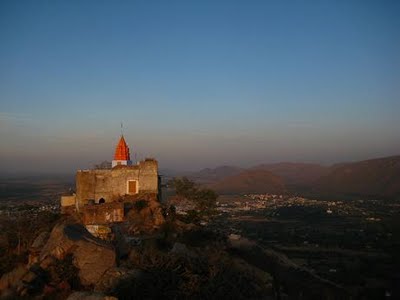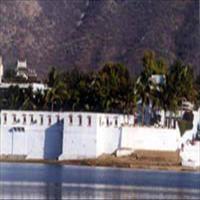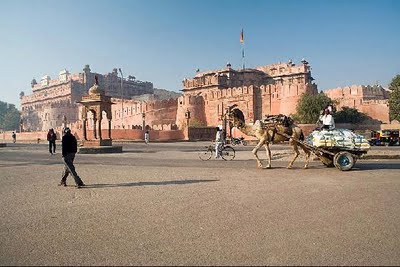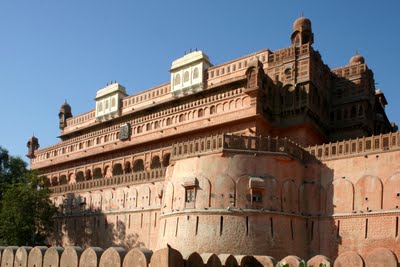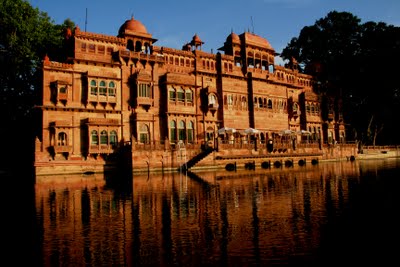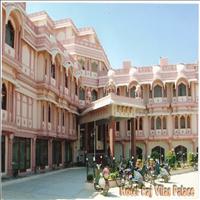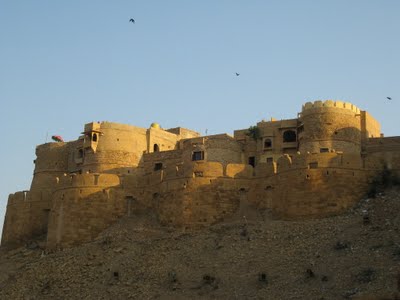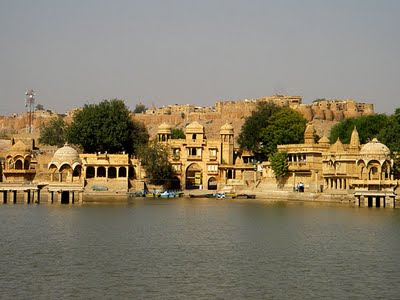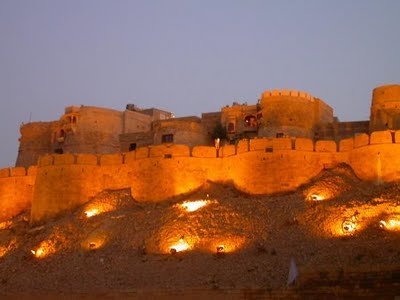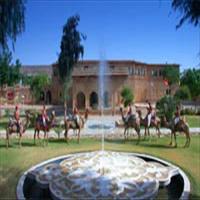Pushkar is all about a semicircular lake with 52 'ghats'. The maximum depth of the lake is 10mteres. It is a holy place and is known as king of all 'tiraths'. A holy dip in this lake on Karthik Purnima is said to wash all the sins and leads to salvation. It is said that the one who bathes in this holy water during the brighter fortnight of the Hindu calendar month Karthik and sees a Varah (an incarnation of Vishnu), will not take a rebirth on this planet again and can enjoy the heavenly bliss forever. The Karthik Purnima holy dip in this lake gives one a blessing equal to hundred penances. There are many yojana spots which cannot be counted by the teacher of gods, Brihaspati.How the name Pushkar came as a mythological story behind it. Once Lord Brahma was worried over the matter of not being prayed to on the earth like the other Gods. He had the desire to have a place on his name on the earth. So he threw a lotus flower which fell on three places and water sprang out from there miraculously. The first place where the flower fell is known as the Jyeshtha Pushkar, the second place is the Madhya Pushkar, and the third place is the Kanishtha Pushkar or Senior, Middle and the Junior respectively. Brahma threw the flower that is the 'Pushpa' with his own hands that is the 'Kar', therefore the name of this place became Pushkar.There are 52 bathing ghats built around the lake. The water of each ghats is supposed to have special powers. Some of which are the Nag Kund for fertility, Roop tirath for beauty, Kapil vyapi Kund water helps cure leprosy and dip in the Mirakand Muni Kund grants the boon of wisdom.
Every year on the day of Karthik Purnima, that is the full moon day in the month of Karthik (somewhere in October - November), the famous Pushkar fair is held here. People from all over the country come to take the holy dip. The town comes alive with folk dancers and musicians who come from all the regions to show their talent. Joyful celebration, cultural variety and cattle market make Pushkar fair famous. This fair is one of the major cultural reflectors of the state of Rajasthan. This is a five day affair when the small town comes alive with cultural activities and vibrant energy.Apart from the religious rituals at the Jagat Pita Shri Brahma Mandir, and other festivities, people participate in a number of sporting and cultural events. The great attraction of this fair other than the variety of folk dances and songs that fill the atmosphere is the camel race and the cattle fair. Cows, Buffaloes, Camels, Horses and even Donkeys are bargained for. This special fair attracts tourists from all over the world.
Location: 11 Kilometers from Ajmer, on the edge of the desert, lies the tiny tranquil town of Pushkar, long the bank of a picturesque Pushkar lake. It is an important pilgrimage spot. The Nag pahar or the snake mountain forms a natural boundary between Ajmer and Pushkar.
Languages Spoken: Rajasthani, Hindi, English
Long Distance Code: +91-145
Importance:World famous for the annual Camel fair and the only Lord Brahma temple.
Area: 5 sq.kms.
Best Time To Visit: July To March
Pushkar Attractions:
Brahma Temple
The only Brahma temple in India where, according to Hindu mythology the creator of earth - Brahma is worshipped. Therefore it has become one of the most important pilgrimage centres for the Hindus. It is nestled in the Pushkar valley which lies beyond Nag parvat and the Ana Sagar Lake. This place is full of natural beauty. It is believed that Lord Brahma, along with other deities performed a Yagnya here. This only temple where Lord Brahma is worshiped is built with marble and decorated with silver coins and has a silver turtle on the floor of. It has a red spire and a goose, considered to be auspicious to Brahma.
Savitri Temple
The temple is situated on the Ratnagiri Hill and is dedicated to Goddess Savitri, the wife of Lord Brahma. An interesting legend is attached to the temple. Once Lord Brahma had to perform a 'Yagna' (a holy rite to appease gods) on a very short notice. Since he could not do this without his wife, he married Gayatri, a local milkmaid after purifying her. When Savitri came to know of all this, she was furious and cursed her husband that he would never be worshipped anywhere except in Pushkar and that too only once a year. She then left for the Ratnagiri Hill and performed self-immolation.
Man Mahal
On the banks of Pushkar is the magnificent palace built by Raja Man Singh - I of Amer. Now it has been converted into an RTDC Hotel Sarovar and offers a comfortable accommodation to the tourists.
Pushkar Lake
Pushkar Lake is said to be very sacred and has said to be originated when the petals from Lord Brahma's lotus fell on the earth and a lake of clear blue water emerged at its place. 500 temples, 52 palaces, and 52 ghats surround the lake. It is at this lake that the world-renowned Pushkar fair is organized on the occasion of Kartik Purnima every year.
Total Rooms : 45
Star Category : 3
The pushkar bagh is an exceptional example of elegance and symmetry in Indian architecture of the last century. The entire bagh is carved out of the famous pink sandstone of Jodhpur it exquisitely captures the romance and grace of a bygone era. The Pushkar Bagh courtyards are peaceful havens where guests can unwind for the day and spend the afternoon leisurely reading or relaxing while capturing the panoramic view of mountains and desert.
Total Rooms : 50
Star Category : 3
Hotel The park city is located in central Pushkar, opposite the city bus stand and next to a gurudwara, with the Pushkar Lake 5 minutes down the road. The rooms are comfortably appointed with all modern amenities and attached with balconies which have great views of a garden. The rooftop restaurant is ideal for dinner as it overlooks the Pushkar Lake .
Total Rooms : 53
Star Category : 3
Hotel Pushkar Palace has well appointed 48 Super Deluxe Rooms and 5 Suites with all facilities in the rooms. Hotel has two floors, most of the rooms including all suites are overlooking the lake and has garden view.
Total Rooms : 136
Star Category : 2.5
"PUSHKAR FORT" offers 16 ethnic Royal Huts, which is situated in the Base of Savitri Temple at Pushkar. It has on offer gorgeous guestrooms for the guests. It pampers them with a wide selection of Maharaja Suites, Maharani Suites, Royal Huts and Swiss Cottages. All these accommodations at this hotel enjoy a very impressive location as they overlook verdant green lawns set in the backdrop of mountains and sand dunes. Apart from elegance, the other feature that characterizes them well is the availability of modern comforts. Some of the modern comforts include television, telephone, air conditioners and en suite bathrooms.Pushkar Fort offers 16 Royal Huts , 10 Deluxe Room, 10 Deluxe AC Tent & 100 Swiss Cottages. Every room has a different view of nature with beautiful Sunset & Sunrise. Tastefully Designed and decorated with antique and modern furniture fixtures. 4 Maharaja Suit, 12 Royal Huts fitted with air conditioning & modern attached bath offers a memorable, peaceful and comfortable stay to guest visiting Pushkar. 125 luxury tents, each 512 sq ft. All have private gardens and an outside deck for sunbathing. The tents have been innovatively crafted using the traditional local artist’s skills and Block printing crafts of Rajasthan. The tents feature Hand crafted wooden furniture, Hand knotted "durries" to cover the floor, separate dressing room with attach showers. All the tents have marble floors and embroidered interior canopies and are furnished in regal style
Total Rooms : 19
Star Category : 0
Teerth Palace Pushkar is in a good and peaceful location, quite suitable for all guests coming to Pushkar. Either you come here for business purpose or sightseeing, you can relax in this comfortable hotel.A warm greeting, a welcoming smile and dedicated reception at the hotel lobby offer you an experience of visiting and staying at the hotel.
